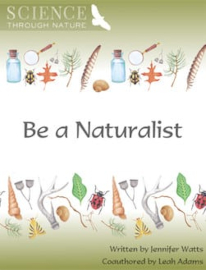Be a Naturalist is a 194-page guide (PDF) designed to help children develop a wonder and appreciation for science through stories and through the exploration of plants, animals, and other wildlife. It is ideal for grades two through five, but you can stretch it to include younger and older students.
The guide is arranged into eight “quests.” Before you begin the first quest, the guide explains how the course works.
Each quest has “PreQuest Prep” information for parents—the objectives, an outline of the quest, a list of supplies, and optional resources. You will need some nature guides for some of the fieldwork. Parents need to preview the quests to decide which elements to use and when.
For the student, each quest begins with a note written to the child by either Kate or Nate, who both work at a nature preserve. Kate and Nate write about their adventures in the nature preserve as a way to teach new topics. Full-color illustrations and photos support the instructional information. Sidebars include notes about the images, activity suggestions, and questions that should be used at the appropriate points. For example, after learning about photosynthesis, a sidebar question prompts the parent to ask,” Can you tell me the process of photosynthesis from beginning to end?” (page 111). Activities in the sidebars are relatively simple, such as a classification activity with household items on page 112.
The notes from Kate and Nate are often lengthier than want you want to cover in one sitting, so there are built-in suggested stopping points to break it up over a few days.
The second part of each quest consists of several encounters with nature through “adventures.” These involve experiments, observations, and hands-on activities, most of which will be done outdoors. It’s easy to adjust if the weather doesn’t permit outdoor adventures on a particular day. The adventures are also adaptable to whatever source of nature you have nearby, whether it’s a nature preserve or your backyard. Each quest’s adventures should be spread out over two to four weeks, and some will overlap since they take time (e.g., growing seeds).
Here are some examples of some of the adventures from the sixth quest, which is about plants: a plant walk where students try to identify a few types of plants (e.g., ferns, conifers, cacti), an experiment (using a live tree) to see what happens to leaves when denied sunlight, an experiment to observe the transfer of dyed water up through celery’s vascular system, and pressing plants to preserve them.
Each quest includes one of these three additional activities as a lengthier adventure.
- Meet a Naturalist teaches about a famous naturalist and their work. The three featured naturalists are John Muir, Anna Comstock, and Henry David Thoreau. These sections include stories about the naturalists plus activities related to their work.
- Nature Art provides an opportunity for students to create a nature-inspired artwork. One example is “land art,” which is made from natural materials and left in the wild. Another is painting rocks to transform them into critters.
- Get Involved suggests a concrete way for students to do something to support wildlife, such as the milkweed-growing project to create a habitat for monarch butterflies. These projects are generally long-term.
Some indoor activities, such as creating an imaginary living creature (page 98) and creating a visual about the four kingdoms of life (page 100), provide rainy-day options. Whether indoor or outdoor, the adventures include prompts to guide students or to help them develop creative ideas.
Worksheets, games, and flashcards reinforce learning from the adventures, and parents can use these as they wish. For the worksheets that require writing, parents might discuss responses rather than requiring students to write, or they might have a child dictate responses for the parent to record.
Within the introductory information, the guide lists additional recommended books and videos that you might use throughout the course. Each quest has lists of even more optional resources (including novels, biographies, and non-fiction) that you might use, with the appropriate age ranges noted next to the entries. Sometimes, the lists include website links.
The eight quests build upon one another, so they should be used in order. You might find that winter in your area makes outdoor exploration impractical, so you might consider using the quests through the fall, spring, and summer, substituting other work during the winter (or just taking time off from science).
Summary
Be a Naturalist does a first-class job of combining nature study with concrete learning activities in ways that suit various types of learners.








